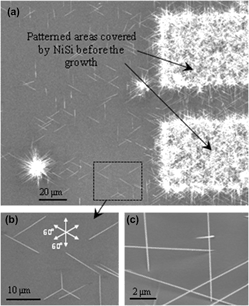Article contents
SiC nanowire vapor–liquid–solid growth using vapor-phase catalyst delivery
Published online by Cambridge University Press: 09 July 2012
Abstract

A method of growing SiC nanowires (NWs) on 4H–SiC surfaces by in situ vapor-phase catalyst delivery was developed as an alternative to the ex situ deposition of the metal catalyst on the targeted surfaces before the NW chemical vapor deposition (CVD) growth. In the proposed method, sublimation of the catalyst from a metal source placed in the hot zone of the CVD reactor, followed by condensation of the catalyst-rich vapor on bare substrate surface was used to form the catalyst nanoparticles required for the vapor–liquid–solid (VLS) growth of SiC NWs. The NW density was found to gradually decrease downstream from the catalyst source and was influenced by both the gas flow rate and by the catalyst diffusion through the boundary layer above the catalyst source. Formation of poly-Si islands at too low value of the C/Si ratio created preferential nucleation centers for misaligned SiC NWs and NW bushes. The flexibility of controlling the nanoparticle density made this technique suitable for NW growth on horizontal surfaces as well as on patterned SiC substrates, including the vertical sidewalls of SiC mesas.
- Type
- Articles
- Information
- Journal of Materials Research , Volume 28 , Issue 1: Focus Issue: Silicon Carbide – Materials, Processing and Devices , 14 January 2013 , pp. 50 - 56
- Copyright
- Copyright © Materials Research Society 2012
References
REFERENCES
- 2
- Cited by


